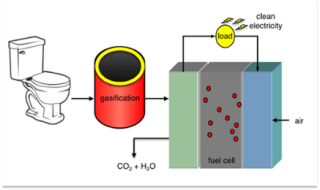Sep 13 2017
Chemical Scientists from the University of Amsterdam’s (UvA) Sustainable Chemistry research priority area collaborated with Chemists at the Copernicus Institute of Sustainable Development of Utrecht University to publish the first ever techno-economic analysis of transforming waste toilet paper (WTP) into electricity. They have reported a two-step procedure and computations of cost per kWh in comparison to that of residential photovoltaic installations in the Energy Technology journal.
 Waste toilet paper can be converted to electricity by gasification followed by reaction with air in a high-temperature fuel cell. Image: UvA/HIMS.
Waste toilet paper can be converted to electricity by gasification followed by reaction with air in a high-temperature fuel cell. Image: UvA/HIMS.
WTP is normally not regarded to be valuable, and the majority of the populations normally do not want to think about it. However, it contains abundant amounts of carbon, including 70-80 wt% of cellulose when dry. People in Western Europe generate averagely 10-14 kg of WTP per person every year. Gathered together in municipal sewage filters, it forms a notable portion of municipal waste.
The ultimate waste has a negative cost
However, at the same time WTP is a businessman's dream as it is one of the very few raw materials with a negative cost. Although this scenario may be different in various regions and countries across the globe, in the Netherlands, wastewater treatment facilities spend nearly 70 Euros per ton of waste to remove WTP. Hence, it is a highly atractive resource as one gets paid for getting rid of it.
Being such “true waste,” WTP offers a great opportunity for closing loops, enhancing resource efficiency and constructing a really circular economy. UvA Chemists regarded the use of WTP as a resource for producing electricity to be “the ultimate waste recycling concept.” Nearly 10,000 tons of WTP is generated per year just in the Amsterdam region, which is enough to supply electricity to 6400 homes.
In addition, as trees are the sources of cellulose contained in WTP, the generated electricity is renewable, thus providing greater chances for satisfying the requirements of renewable energy. The availability of renewable resources is normally discontinuous. Recycling of plant stems can be done only after the harvest; sunlight can be tapped only during the daytime, and can be restricted by cloud cover; and wind power cannot be easily predicted. However, WTP is a continuously obtainable resource.
Two-step process
The Amsterdam-Utrecht research project headed by Gadi Rothenberg and Bob van de Zwaan, UvA Professors and belonging to UvA’s Van ‘t Hoff Institute for Molecular Sciences, came up with a simple two-step procedure for transforming WTP into electricity, making a direct course from unwanted waste to a usable end product.
Els van der Roest, a Master’s Student, investigated the likelihood of integrating devices for gasifying WTP, that is, step 1, by using high-temperature solid oxide fuel cells (SOFCs) with the ability to directly transform the gasified WTP into electricity, that is, step 2.
The aim of the project was to evaluate the viability of such a WTP-to-electricity system with the ability to supply 10,000 ton WTP per year, dependent on values of real-time parameters. The Researchers used techno-economic evaluation techniques and came up with a basic procedural design, a net energy balance and a profitable research for this idea. Data required for the experiments and computations were acquired in cooperation with the Amsterdam waste-to-energy company (afvalenergiebedrijf, AEB).
Efficiency of a natural gas power plant
The Researchers have reported the basic system design and also its electricity production and net efficiency, dependent on detailed mass and energy balance computation, in an open-access paper published in Energy Technology, an international peer-reviewed journal.
The net electric efficiency of the system is 57%, identical to efficiency of a natural gas combined cycle plant. The LCOE or levelized cost of electricity—which is a measure adapted for consistent comparison of electricity production techniques—is 20.3 ¢/kWh, which, at present, is comparable to that of residential photovoltaic installations.
The investment cost of the system is comparatively high, predominantly because of the fuel cell capital costs. However, this cost is anticipated to get lesser once the market for fuel cells grows. The operating costs are comparatively very less, somewhat due to the high thermodynamic efficiency of nearly 70%. The Scientists anticipate that learning impacts can render the system highly competitive in the years to come, at an LCOE of nearly 11 ¢/kWh.
The Researchers conclude that converting WTP into electricity has a bright future.
When we discuss these results with companies, people get very excited.
Professor Rothenberg, UvA Professor and Head of the Research Project
Yet, the fact is, to date, no municipal authority or Dutch company has come forward to invest in further expansion. The Researchers are now looking forward to taking their idea abroad, “We might see the first WTP-to-electricity plant being built in China,” stated Rothenberg.